10 Outrageous Orange Perennial Flowers To Grow In Your Garden

This post follows our research editorial guidelines.

If you’re looking to add a pop of color to your garden, orange perennials are an excellent choice. These vibrant plants can add a bold and cheerful touch to any landscape, especially when combined with yellow perennials and other warm color pallets.

Want to make a statement in your garden this year? Try growing these hardy flowers that come back every year with little care or maintenance. Let’s explore some of the most beautiful and interesting orange perennials that are sure to catch your eye.
Quickly Find Orange Flowering Perennials:
1. Butterfly Weed (Asclepias tuberosa)

With multiple ascending coarse stems and bowl-shaped flowers, butterfly weeds are native to eastern and southwestern North America. They belong to the Asclepias family and have long been used in herbal remedies.
Companion planting Tips🦋
Butterfly Weed is one of my favorite flowers to plant among other drought-tolerant full-sun perennials like Coneflowers and Black-eyed Suzans. Look for companion varieties that have a similar warm tone to elevate your garden design. As an added benefit, planting Butterfly Weeds aids in the efforts to protect the monarch butterfly and its native habitat.
Blooming from early through late summer, this tuberous-rooted perennial plant requires gritty soil, adequate sun exposure, and very little aftercare. Butterfly weeds attract a legion of butterflies, and they get bushier with age. Remember to pinch back young stems to achieve a disheveled appearance.
| Botanical Name: | Asclepias tuberosa |
| Growth Rate: | Slow |
| Native Range: | Eastern and Southwestern North America |
| Hardiness Zones: | 3 to 9 |
| Soil Needs: | Fast-draining, gritty soil |
| Blooming Period: | Early to late summer |
| Water needs: | Low |
| Exposure: | Full sun |
2. Alstroemeria Apricot (Alstroemeria ‘Koncahusky’)
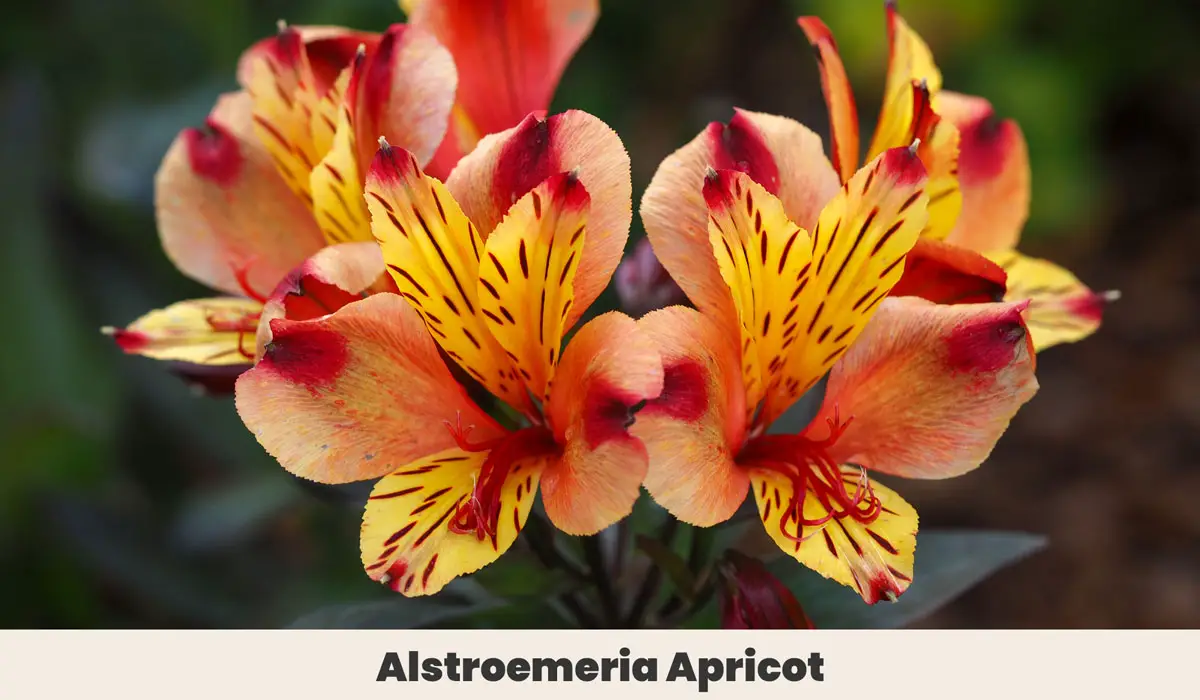
Alstroemeria apricots are vibrant, long flowering perennials that grow 25cm tall and 30cm wide. They come in a wide range of colors, such as yellow, orange, pink, and purple.
The tuberous perennial boasts lily-like apricot flowers with striking soft brown spots and green waxy foliage. Also known as “Peruvian Lilly”, these flowering blossoms thrive in warmer regions.
| Botanical Name: | Alstroemeria Hybrida Dwarf Apricot |
| Growth Rate: | Fast |
| Native Range: | South America |
| Hardiness Zones: | 7-10 |
| Soil Needs: | Moist, Well-drained |
| Blooming Period | Late spring to early fall, depending on conditions |
| Water needs: | High |
| Exposure: | Full sun to partial shade |
3. Orange Tiger Lily (Lilium bulbiferum var. croceum)
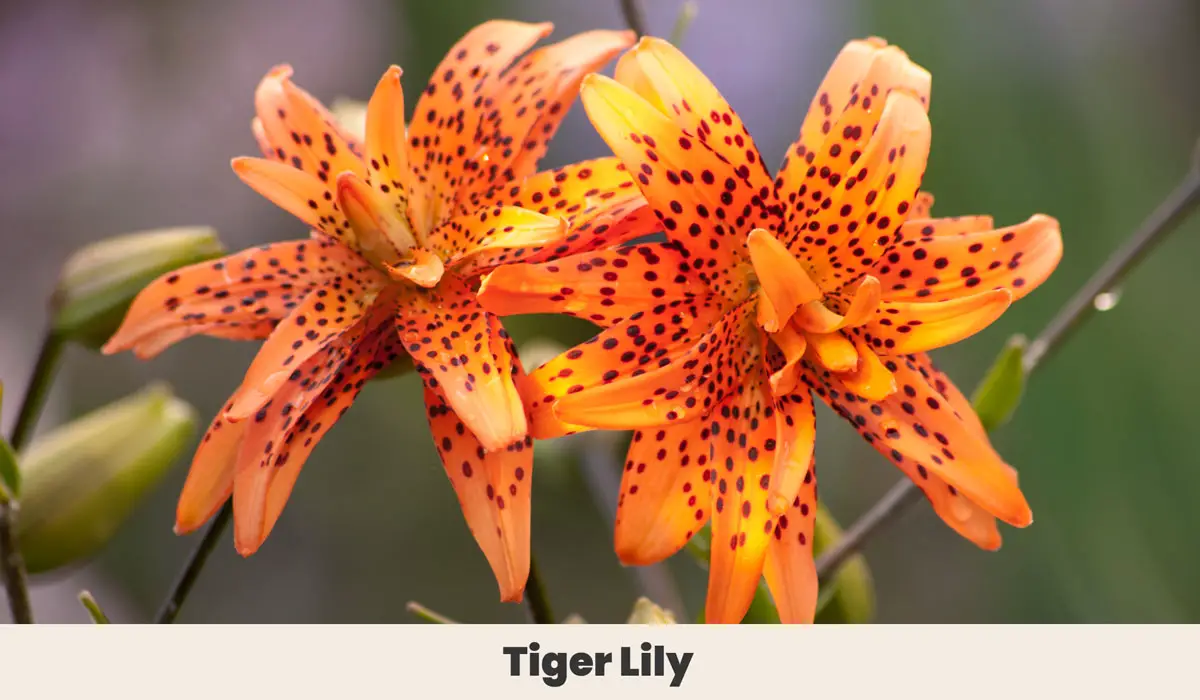
Orange lily is a herbaceous perennial with underground bulbs, growing all year-round. Blooming in early summer with striking, flaming orange petal tips, these perennial plants are excellent border plants.
Since it has average watering needs, orange lilies can be a viable option for those looking for a hassle-free, low-maintenance flowering plant.
| Botanical Name: | Lilium bulbiferum var. croceum |
| Growth Rate: | Fast |
| Native Range: | Europe |
| Hardiness Zones: | 3-9 |
| Soil Needs: | Moist, well-drained |
| Blooming Period: | Early to mid-summer |
| Water needs: | Low |
| Exposure: | Full sun to partial shade |
4. Bird of Paradise (Strelitzia reginae)

Birds of Paradise belongs to the Streliziaceae family and is acclaimed for its unique exotic flowers and inherently large glucous leaves. With distinct gray-green leaves and brilliant orange flowers, this ornamental plant is indigenous to the arid regions of South Africa.
Tropical Garden Paradise🌴
If you happen to live in a warm climate that allows for Birds of Paradise to overwinter, try creating your own lush garden oasis. Plant among other tropicals like hibiscus, canna, and palms.
Due to its enormous size, the green leaves are good for air circulation. If you live in a colder region like me try growing Birds of Paradise indoors, they make a great tropical houseplant.
| Botanical Name: | Strelitzia reginae |
| Growth Rate: | Fast |
| Native Range: | South Africa |
| Hardiness Zones: | 10-12 |
| Soil Needs: | Moist, Well-drained |
| Blooming Period: | Winter to spring, though in some climates, it can bloom sporadically throughout the year. |
| Water needs: | High |
| Exposure: | Full sun to light shade |
5. Monkey Flower (Mimulus ringens)

Monkeyflower is a flowering herbaceous perennial that is known for its mouth-like shaped flowers, resembling a monkey. Native to North America, its genus Mimulus can be found in other parts like Asia, Africa, and Australia.
It grows quickly in damp soil and requires a regular watering schedule. Try planting Monkey flowers along the edges of pond edges and rain gardens.
| Botanical Name: | Mimulus ringens |
| Growth Rate: | Moderate |
| Native Range: | North America |
| Hardiness Zones: | 3-9 |
| Soil Needs: | Moist, Well drained |
| Blooming Period: | Late spring to early fall |
| Water needs: | Moderate |
| Exposure: | Full sun to partial shade |
6. Rock Rose (Cistus)
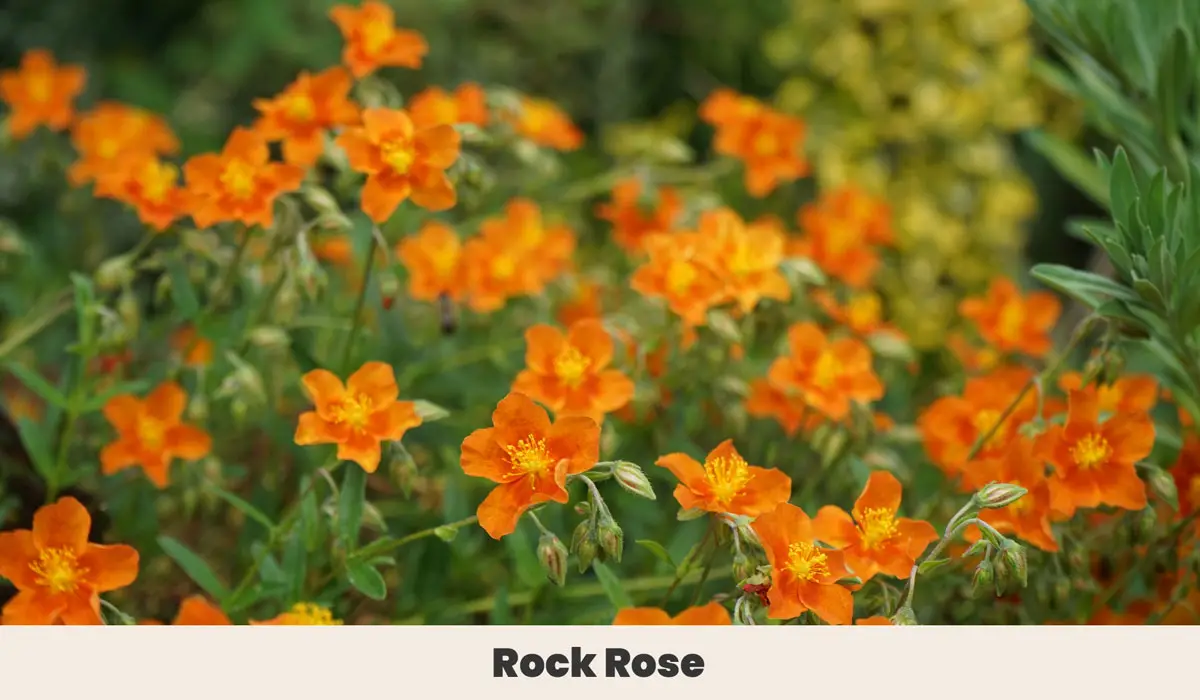
Rock rose is an evergreen perennial that is commonly used in herbal tinctures like the Bach flower remedies.
These medium-sized shrubs are native to the Mediterranean region. Rock roses have shown themselves to be ‘tough as nails’ in all soil conditions making it an excellent addition to your xeriscaping garden once established.
| Botanical Name: | Cistus |
| Growth Rate: | Moderate fast |
| Native Range: | Mediterranean region of Europe |
| Hardiness Zones: | 8-11 |
| Soil Needs: | Moist, Well drained |
| Blooming Period: | Late spring to early summer |
| Water needs: | Low |
| Exposure: | Full sun |
7. Sneezeweed (Helenium autumnale)
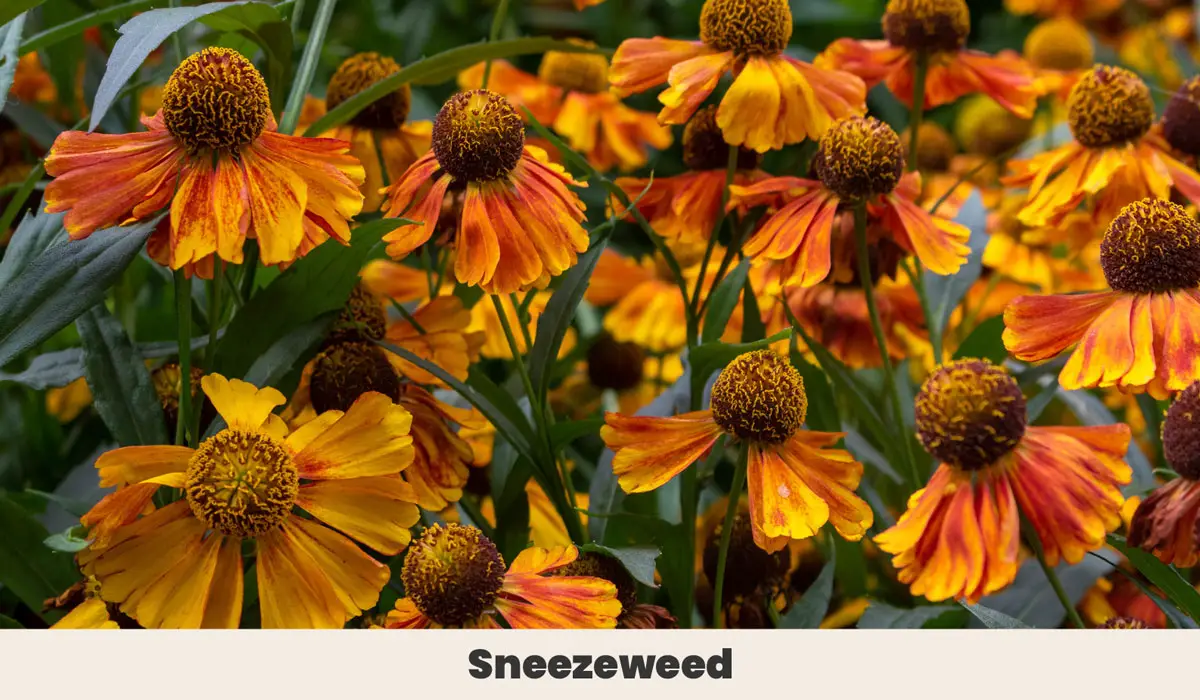
Sneezeweed is one of the ‘coneflowers’, belonging to the Asteraceae family. Its abundant blooms can be found in late Summer or Fall. With erect, branching stems and clump-forming flowers, sneezeweed can be cultivated in any soil condition.
Planting Pairs Reccomendation 🌻
As you plan your summer garden try incorporating Sneezeweed among other late bloomers like Asters and Goldenrod. This will create a cascading effect as one flower ends and a new one begins.
Formerly, its dried leaves were used in the powdered form to get rid of evil spirits. In recent times, sneezeweed has proved effective in treating colds and headaches. It’s also included in my list of the 12 flowers that look like daisies that I’ve written about.
| Botanical Name: | Helenium autumnale |
| Growth Rate: | Fast |
| Native Range: | North America |
| Hardiness Zones: | 3-8 |
| Soil Needs: | Wet or Moist Soil |
| Blooming Period: | Late summer to early fall |
| Water needs: | Low |
| Exposure: | Full sun |
8. Globeflower (Trollius ledebourii)
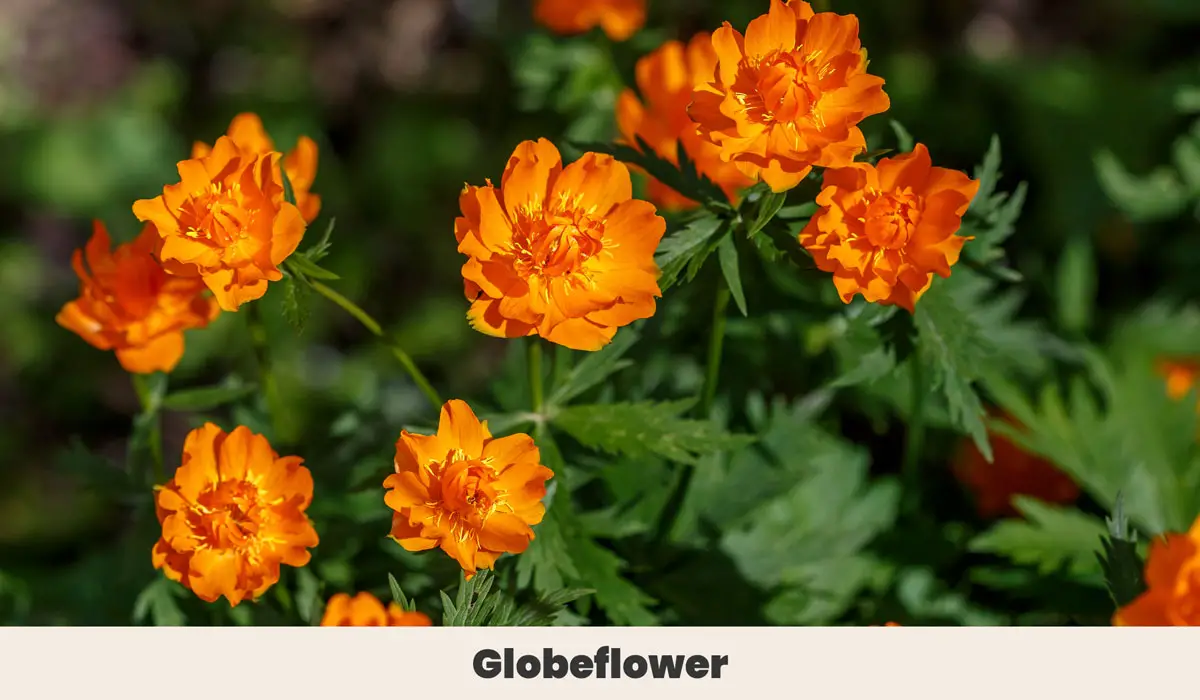
Globe flowers are titular round flowers growing in shades of yellow and orange. This perennial flowering plant requires very moist soil, so frequent watering is expected.
Native to Europe and Western Asia, these flowers are used by gardeners for their ability to attract hummingbirds.
| Botanical Name: | Trollius Ledebourii |
| Growth Rate: | Moderate |
| Native Range: | Europe and Western Asia |
| Hardiness Zones: | 3-8 |
| Soil Needs: | Humus-rich moist soil |
| Blooming Period: | Late spring to early summer |
| Water needs: | Medium |
| Exposure: | Full sun to partial shade |
9. Fool’s Gold (Abutilon)

Fool’s gold is an upright semi-evergreen shrub that can be cultivated in poor soil. With bright orange tassel-like flowers, this herbaceous perennial is found in North America.
You can grow it in a loam-based potting compost as long as it gets direct sun rays. Fool’s Gold is one of the many flowers I love that are shaped like little bells.
| Botanical Name: | Abutilon |
| Growth Rate: | Medium |
| Native Range: | North America |
| Hardiness Zones: | 1-5 |
| Soil Needs: | Moist, Well-drained |
| Blooming Period: | Spring to fall, depending on the variety and conditions |
| Water needs: | Medium |
| Exposure: | Full sun to partial shade |
10. Crown Imperial (Fritillaria imperialis)

Crown imperial is a bulbous perennial perched atop tall stems. These bright golden-orange bell-shaped flowers are surrounded by small leaves, which also act as a great pest repellant.
These perennial plants are pretty much impervious to any issues, so it requires less maintenance and after-care.
| Botanical Name: | Fritillaria imperiallis |
| Growth Rate: | Moderate |
| Native Range: | Western Asia and the Middle East |
| Hardiness Zones: | 5 to 8 |
| Soil Needs: | Moist, well-drained |
| Blooming Period: | Early to mid-spring |
| Water needs: | Average |
| Exposure: | Full sun to light shade |
Final Thoughts
While growing flowers in your garden can be cumbersome, these outrageous perennials add a pop of color, no matter the season. Based on your specific planting needs, you can take the time to slowly build your garden.
After choosing the right orange perennial, you can enjoy the splendid view of the growing blooms without making changes to your standard gardening schedule.

Before you go!
10 Flowers I’ve Found That Look Like Butterflies
From Boring to Breathtaking: Discover the Top Flowers to Pair with Carnations!
12 Tall Perennials With The Best Pink Flowers in Bloom
11 Plants With Year-Round Flowers – Enjoy Gardening in Full Bloom